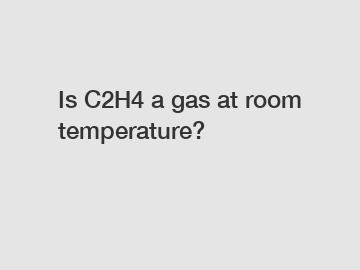Is C2H4 a gas at room temperature?
Is C2H4 a gas at room temperature?
C2H4, also known as ethene or ethylene, is a hydrocarbon with the molecular formula C2H4. It is an important industrial chemical widely used in the production of plastics, solvents, and various organic compounds. When it comes to its physical state at room temperature, C2H4 indeed exists as a gas. Let's delve into this topic further and discuss why C2H4 is a gas at room temperature and its properties.
Point 1: Low boiling point.

One of the primary reasons why C2H4 is a gas at room temperature is its low boiling point. Ethene boils at -103.7 degrees Celsius (-154.7 degrees Fahrenheit), which is well below room temperature. This means that even at relatively low temperatures, ethene molecules have enough energy to transition from the liquid to the gaseous state. As a result, C2H4 exists as a gas rather than a liquid under normal conditions.
Point 2: Weak intermolecular forces.
Another factor contributing to C2H4's gaseous state at room temperature is the relatively weak intermolecular forces present in the compound. Ethene consists of carbon and hydrogen atoms, which form simple covalent bonds. These bonds are relatively nonpolar, leading to weak intermolecular forces between ethene molecules. As a result, it requires minimal energy for these molecules to overcome these weak forces and transition into the gas phase.
Explore more:What is vinnapas 8034 h used for?
Unlocking the Secrets of Chemical Compound 663172-78-9
What is the use of HPMC polymer?
Which supplier offers the best price for Caustic Soda Pearls 99?
What is the difference between cellulose and HPMC?
What is a pharmaceutical intermediate?
Which industries can benefit from sulfur hexabromide?
Point 3: Lack of significant intermolecular interactions.
Furthermore, C2H4 lacks significant intermolecular interactions that would promote the formation of a condensed phase, such as a liquid or solid, at room temperature. In contrast to more complex molecules with multiple functional groups, ethene lacks the ability to form extensive hydrogen bonding or dipole-dipole interactions. These stronger interactions commonly seen in compounds like alcohols or carbonyl-containing compounds create additional forces that can immobilize molecules, leading to a condensed phase. However, due to its simple structure, C2H4 does not have these intermolecular interactions, allowing it to remain in the gaseous state at room temperature.
Point 4: The effect of pressure.
The state of a substance can also be affected by pressure. Although at standard atmospheric pressure ethene exists as a gas, applying pressure can cause it to condense into a liquid. By increasing the pressure above a certain critical value (51.3 bar), C2H4 can undergo a phase change and transform into a liquid, regardless of the temperature. This pressure-induced condensation occurs due to the compression of gas molecules, forcing them close enough together for attractive forces to become significant.
In conclusion, C2H4 is indeed a gas at room temperature due to its low boiling point, weak intermolecular forces, and lack of significant intermolecular interactions. These factors facilitate the existence of ethene molecules in the gaseous phase under normal conditions. However, it is essential to note that pressure can play a crucial role in altering the state of C2H4, allowing it to condense into a liquid. Understanding the physical properties of C2H4 is significant for various industrial applications, as its gaseous state enables its utilization in manufacturing processes, such as polymerization reactions that produce a wide range of plastic materials.
For more sulphur hexafluoride price, nf3 specialty gas, sulfur hexafluoride saleinformation, please contact us. We will provide professional answers.
Explore more:What is FDCA used for?
How to Use Polycarboxylate?
What Is Polycarboxylate Used for in Dentistry?
What is the use of CAS 1451 82 7?
Retaine HPMC or Retaine MGD: Which Solution Works Best for Dry Eyes?
Which Sustainable Practices are Revolutionizing Chemical Trading?"Note: This question highlights the growing trend of sustainability in the chemical trading business and raises curiosity about the inn
Which Modified Cellulose Ether is the Game-Changer for Sustainable Packaging?










